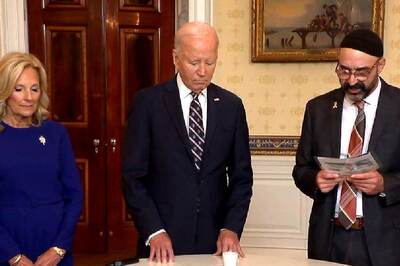
views
From the astonishing turnaround win against Australia the same time last year, to the pusillanimous surrender against South Africa in the recent series, Indian cricket has traversed an agonizingly disappointing path.
Last year, a full-strength Australian team was beaten by a beleaguered Indian team missing several star players, and having lost the first Test badly which included the ignominy of being bowled out for 36. In the following three Tests, India battled brilliantly to win two and save one match with the odds stashed heavily against them.
Against South Africa, it was the other way around. India were at full strength while the Proteas were in turmoil. Controversy over racism in the country’s cricket was boiling over. With several key players (Amla, de Villiers, Philander, du Plessis) having retired or quit the five-day format in the past few years, the team was considerably weaker than in 2018.
India vs South Africa: Full Coverage | Photos | Schedule | Results
This was compounded by the injury to star bowler Anrich Nortje before the series began, and brilliant wicket-keeper batsman Quinton de Kock quitting Test cricket after the first Test. The prospects of South Africa surviving a massive series defeat after losing the first match by a wide margin were close to nil.
As it transpired, there were shocks galore for India in the next two Tests. On the face of it, the vastly contrasting results in Australia (2020-21) and South Africa (2021-22) are surprising. Whether this is a conundrum or something more serious, as results of overseas matches suggest, is something that needs to be put to harsh scrutiny.
The World Test Championship final was lost to New Zealand. India were ranked no.1 and favourites, but the Kiwis turned the tables in a hard-fought match. The series against England is still to be decided. India are leading 2-1 with one match to be played, but this too has been a tough contest though England were among the weakest teams in the world even playing at home.
Now comes this defeat to South Africa. In fact it is a debacle. To be beaten in two matches on the trot to a side that looked to be easy picking when the series started was an unexpected and massive slump. It raises multiple questions about the country’s much-touted talent pool as well as selection policy, especially in picking playing XIs on tour.
Brittle batting was India’s bugbear once again, as it has been for over two years now. There was only one score in excess of 300, in the first Test. That India won this match is clear pointer where the major problem lay. In the next two Tests, India’s totals hovered a little over 200 and slumped to 198 in the crucial second innings of the third match which gave South Africa a fairly easy target to overhaul.
In overseas matches in SENA countries visiting teams scoring less than 325-350 in the first innings leave themselves vulnerable, more so in low scoring contests. India squandered the advantage of winning the toss in the second and third Tests positing below par first innings scores and ended up paying a heavy price.
Technical and temperamental shortcomings led to startling and frequent collapses which kept South Africa in the hunt for wins even when they conceded first innings lead. That the relatively inexperienced Proteas won the second and third Tests by seven wickets each time was because they showed more courage, character, composure and calibre than the vastly more experienced, star-studded Indian team.
India had two century-makers in the series (Rahul and Pant) , South Africa none. But don’t let this stat confound you. Of the top 5 run scorers, three were South Africans. Not just that, players like Dean Elgar, Temba Bavuma and Keegan Peterson made runs when it mattered most, in the second innings, making light of seemingly daunting run chases, riding on gumption, controlled aggressiom and in the case of Peterson certainly, enthralling strokeplay.
In contrast, India’s top order batting looked largely tepid, tentative and burdened. Senior pros Rahane and Pujara, under pressure before the start of the series, made it worse for themselves with failure after failure. Some who did click, like Rahul, Kohli, Pant, were unable to sustain form through the series, and their inconsistency hurt India badly.
Rohit Sharma’s absence was acutely felt, and Kohli missing the second Test was no doubt a blow. Yet, what batting resources India had should have been good enough to get the better of South Africa. Failure to do so must be considered a monumental flop show. Even Kohli, who showed signs of emerging from a lean trot, couldn’t establish the authority in the middle as he was known to do when at his best. His stonewalling 29 in the second innings of the last Test allowed the South African pace bowlers to throttle the runs despite Pant’s pyrotechnics at the other end.
Why Hanuma Vihari, who made a fine impression playing the second Test for the injured Kohli, was dropped for the third was a rank bad call. To plump for the experience of Pujara or Rahane, both out of sorts, and drop an in-form batsman showed not just poor tactic but also an apprehensive mindset: Fear of defeat made the team management cling on to struggling veterans who themselves may have wanted time out!
India’s selectors, Rahul Dravid and Virat Kohli have serious head-scratching to do about the top order batting after this adverse result. In home conditions, Indian batsmen make merry, but are getting exposed overseas far too often. Some heads will roll one suspects.
The pace bowlers were terrific, tried their best, but with poor scores to defend, were left wringing their hands in despair. It must be said though that even in this department, Bumrah, Shami, Thakur and Co upstaged by Rabada, Jansen, Ngidi, Olivier. This was particularly true when bowling in the second innings, where the South Africans bowled with greater parsimony and probed the batsmen harder, whereas India’s bowlers flagged in similar situations.
In the first innings, the Indian attack picked up 30 wickets in the series, in the second innings only 16, and at almost twice the cost, which is a telling statistic. Add to this fantastic fielding, particularly in the slips, and the home team was ahead in all departments of the game.
In fact, so good were the South Aricans that they can now look at the future with optimism. Peterson is a batsman out of the top drawer and debutant Marcus Jansen sustained control and hostility marks him out as a special talent. Rabada was a stellar spearhead and Ngidi delivered whenever the ball was thrown at him.
In Elgar, South Africa also have a captain who is brave, cussedly determined, but also has a calm head even in the deepest crisis, which helps him hold the team together. He was unfazed by India’s superior ranking and the star status of its many players, and this rubbed off on all his players who battled hard and without complex.
India had their moments, but couldn’t drive the advantage home when it mattered. That Kohli’s pique at the DRS decision going Elgar’s way in the last Test became the defining moment of India’s attempt win the series is poor comment on the team’s resolve. There are shortcomings in technology, true, but to blow a fuse like Kohi did was poor form. There are decisions in the past which may have gone in India’s favour, so these things even out.
Kohli’s unsavoury outburst only highlighted the frustration and anger that had been building up in the dressing room. The root cause of this was the inadequacies of his own team, not technology. Had the passion and aggression been channelized better, just maybe there could have been a different story to tell.
Get the latest Cricket News, Schedule and Cricket Live Scores here


















Comments
0 comment